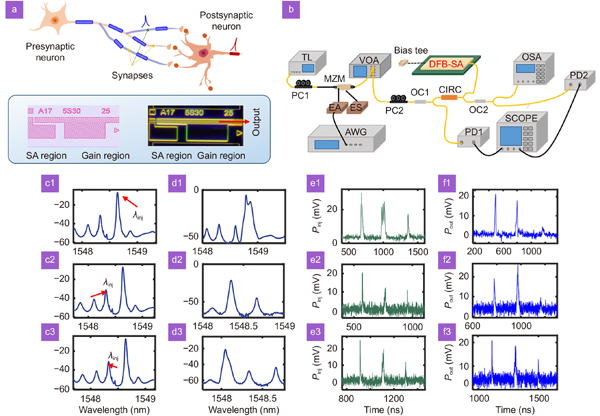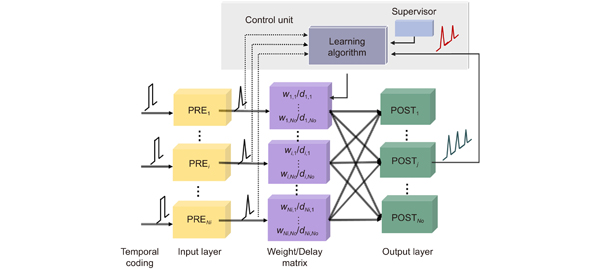Yanan Han, Shuiying Xiang, Ziwei Song, Shuang Gao, Xingxing Guo, Yahui Zhang, Yuechun Shi, Xiangfei Chen, Yue Hao. Pattern recognition in multi-synaptic photonic spiking neural networks based on a DFB-SA chip[J]. Opto-Electronic Science, 2023, 2(9): 230021-1
Search by keywords or author
- Opto-Electronic Science
- Vol. 2, Issue 9, 230021-1 (2023)

Fig. 1. (a ) The geometry of multi-synaptic connections. (b ) The experimental setup. The optical path is denoted by yellow, and the electrical path is black. The GDS file and chip micrograph of the DFB-SA neuron chip. (c1 –c3 ) The optical spectrum of free-running DFB-SA, marked with different injection wavelengths. (d1–d3 ) The optical spectrum of DFB-SA with external optical injection corresponding to (c1–c3). (e1 –e3 ) and (f1 –f3 ) The input pattern and the corresponding output.

Fig. 2. The basic structure for supervised learning of photonic SNNs with temporal coding.
Fig. 3. (a ) The process of digit pattern recognition based on a multi-synaptic photonic spiking neural network. (b ) The output classification. (c ) The basic principle for temporal coding SNN. (d ) The STDP rule. (e ) The mean distance of 4 different training methods with different Nsyn.
Fig. 4. The output spike timing of all 10 output neurons (the row) at the input of all 10 patterns (the column) when Nsyn=3.
Fig. 5. (a ) The converged Distance with 1, 2, and 3 synapses, respectively. (b1 –b2 ) Normalized weights for each of the two sets of synapses after convergence. (c1 –c2 ) Normalized delays for each of the two sets of synapses after convergence. (d1 ) The converged Distance in the parameter space of weight mismatch and delay mismatch and (d2 ) projection of the contour with Distance=1.
Fig. 6. (a1 –j1 ) The input spike patterns for all the 10 output neurons. (a2 –j2 ) The correlated outputs of DFB-SA. (k1 ) The output spike interval for all 10 output neurons of 20 experiment trials. (k2 ) The output spike power for all 10 output neurons of 20 experiment trials.
|
Table 1. Accuracy of MNIST classification based on different models with different Nsyn.

Set citation alerts for the article
Please enter your email address



